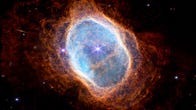Over the past few decades, NASA’s space telescopes discovered thousands of new planets located beyond our solar system. But astronomers were forced to wait for the next generation of advanced observatories to get a closer look at these exoplanets to see if they might harbor the building blocks of life.
The space agency’s long-awaited James Webb Space Telescope is one such next-gen telescope. And just a few months into its official science operations, it’s already delivered the goods by detecting clear evidence of carbon dioxide in the atmosphere of an exoplanet for the first time.
“As soon as the data appeared on my screen, the whopping carbon dioxide feature grabbed me,” Zafar Rustamkulov, a Johns Hopkins University graduate student and part of the research team, said in a statement. “It was a special moment, crossing an important threshold in exoplanet sciences.”
The finding was published in a paper in the journal Nature on Thursday.
Webb’s Near-Infrared Spectrograph analyzed starlight passing through the atmosphere of the giant gas planet WASP-39b, which is a massive warm fuzzy of a world. The planet has a mass about a quarter that of Jupiter but a diameter 1.3 times larger, making it quite a puffy planet.
The analysis revealed an unequivocal detection of CO2, which is well known for being associated with life here on Earth. While it seems unlikely that there is life as we know it on WASP 39b where temperatures are consistently about 1,600 degrees Fahrenheit (900 degrees Celsius), scientists are excited by the display of Webb’s capabilities.
“Detecting such a clear signal of carbon dioxide on WASP-39 b bodes well for the detection of atmospheres on smaller, terrestrial-sized planets,” said Natalie Batalha, of the University of California, Santa Cruz, who leads the team.
Such planets are, of course, more like Earth and we’d like to think are therefore more likely to be places where the conditions to support life can be found.
Nobody is saying Webb has spotted aliens just yet, but it could be one of the devices we use to spot their distant exhaust.


